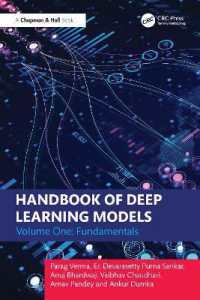- ホーム
- > 洋書
- > 英文書
- > Business / Economics
Full Description
This book presents a collection of studies that have applied analytical methods to improve preparedness, planning, and a faster response to A&E and public health emergencies like epidemic and disease outbreak. It explores the application of quantitative Operational Research techniques such as Mathematical Modelling and Optimization, Maximum Likelihood Estimation, Multiple-Criteria Decision Analysis, Discrete-event Simulation, Data Mining, and Bayesian Decision Models. These techniques have been used for better management of emergency care, including first responders, ambulance services, A&E departments, and mass immunisation centres. This volume focuses on planning at the operational level whereas volume 2 focuses mainly on planning at the strategic level.
The OR Essentials series presents a unique cross-section of high quality research work fundamental to understanding contemporary issues and research across a range of Operational Research (OR) topics. It brings together some of the best research papers from the highly respected journals of the Operational Research Society, also published by Palgrave Macmillan.
Contents
1. A Synthesis Of Operational Research For Emergency Planning In Healthcare Through The Triple Lens Of Technique-Domain-Context; N. Mustafee PART I: OR FOR LOCATING EMERGENCY SERVICES 2. Locating Emergency Services With Different Priorities: The Priority Queuing Covering Location Problem; F. Silva And D. Serra 3. Decision Support Tools For Ambulance Dispatch And Relocation; T. Andersson And P. Varbrand 4. A Study Of Situationally Aware Routing For Emergency Responders; M. J. Henchey, R. Batta, A. Blatt, M. Flanigan And K. Majka PART II: OR FOR OPERATIONAL PLANNING IN EMERGENCY SERVICES 5. Multi-Criteria Approach Using Simulation-Based Balanced Scorecard For Supporting Decisions In Health-Care Facilities: An Emergency Department Case Study; W. Abo-Hamad And A. Arisha 6. Combining Data Mining And Discrete Event Simulation For A Value-Added View Of A Hospital Emergency Department; R. Ceglowski, L. Churilov And J. Wasserthiel 7. Uncovering Effective Process Improvement Strategies In An Emergency Department Using Discrete Event Simulation; O.H. Choon, Z. Dali, P.T. Beng And C.P.Y Magdalene 8. Improving The Design And Operation Of An Integrated Emergency Post Via Simulation; N.J. Borgman, M.R.K. Mes, I.M.H Vliegen And E.W. Hans 9. A Simulation Case Study To Improve Staffing Decisions At Mass Immunization Clinics For Pandemic Influenza; M. F. Beeler, D. M. Aleman And M. W. Carter 10. Modelling Treatment Effects In The HIV/AIDS Epidemic; J.D. Griffiths, Z.F. Lawson And J.E. Williams PART III: OR FOR INVENTORY MANAGEMENT IN EMERGENCY SERVICES 11. Impact Of The Influenza Season On A Hospital From A Pharmaceutical Inventory Management Perspective; A. R. Vila-Parrish, J. S. Ivy And B. He 12. Perishable Inventory Management System With A Minimum Volume Constraint; Z. Shen, M. Dessouky And F. Ordonez 13. A Bayesian Decision Model With Hurricane Forecast Updates For Emergency Supplies Inventory Management; S. Taskin And E.J. Lodree 14. Using Simulation To Improve The Blood Supply Chain; K. Katsaliaki And S.C. Brailsford








